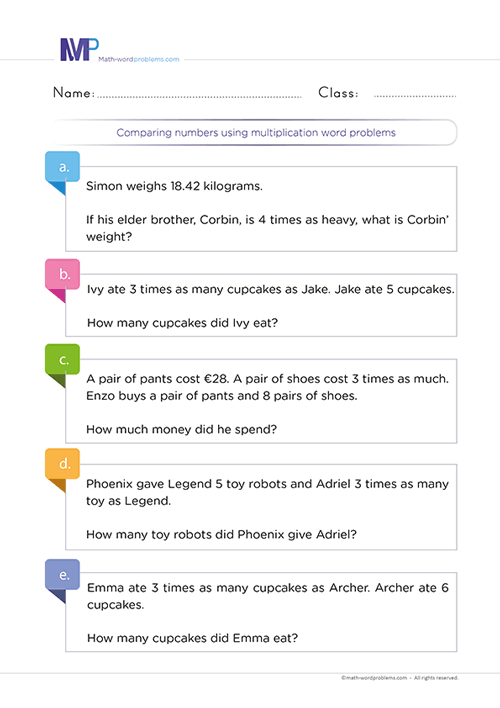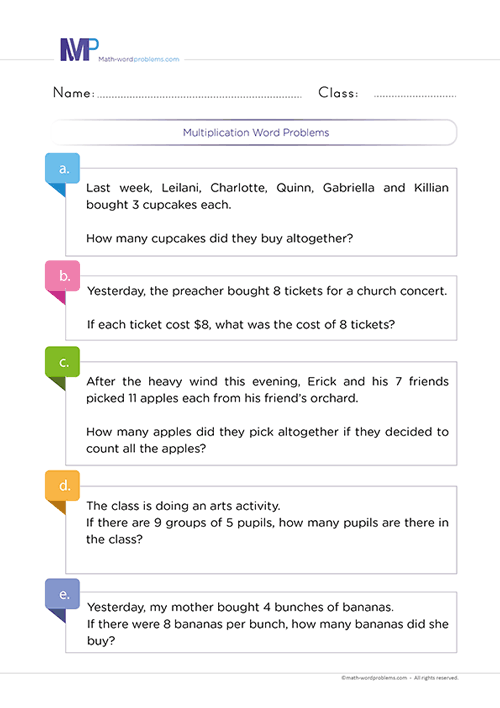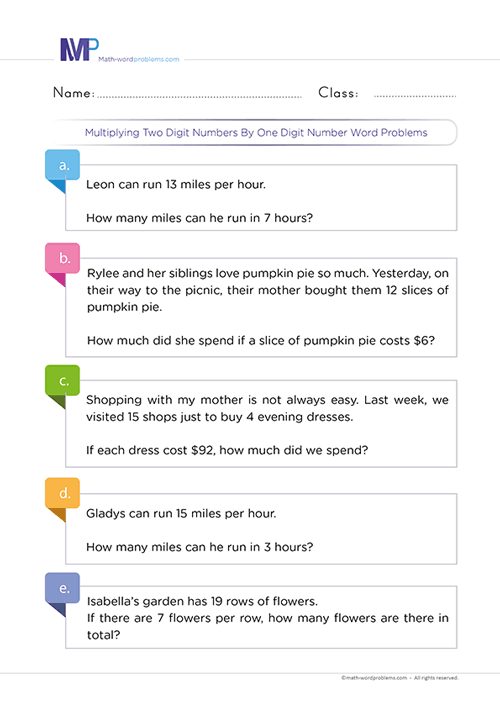 How to compare numbers using multiplication word problems
How to compare numbers using multiplication word problems

- INTRODUCTION
- Step 1 Identify
- Step 2 STRATEGIZE
- Step 3 SET UP
- Step 4 PROVIDE A SOLUTION
- Step 5 CHECK YOUR WORK
Get more contents on this skill...
Find here a better way with steps on how to compare numbers using multiplication word problems. These steps, with their designs, will greatly inspire and motivate 3rd graders' to accurately translate inconsistent word problem statements into a solvable numerical equation.
In addition, this guide will provide every step and strategy kids need to build a concrete experience and skills on how to compare numbers using multiplication word problems.
Steps on how to compare numbers using multiplication word problems
Our unique steps on how to compare numbers using multiplication word problems will wipe out all the misconceptions kids usually have concerning whether a number is equal to, lesser than, or greater than the other.
In an effort to master these steps, your 3rd Grader's math skills will positively enhance understanding, interest, and motivation in comparing numbers using multiplication. As a result, learners will overcome all the problems they encounter in comparing numbers using multiplication word problems.
To show kids how practical these steps work, we have designed a few inspirational real-life examples following the consistent steps below.
Step 1 IDENTIFY THE PROBLEM
To identify the problem,
- You can begin by studying/reading out the problem carefully to understand it.
- Then, identify and highlight relative statements.
- Now, reread the problem and figure out the important numbers and keywords in the problem.
As we were saying, if a word problem requires you to perform a multiplication operation, especially when it involves comparing numbers using multiplication, you will find at least one of the following keywords in the word problem: - twice/thrice (as much as, as long as, as heavy as, as light as, as many as, as old as, as young as), 4, 5, 6, times (as much as, as many as, as long as, as heavy as, as light as, as old as, as young as), etc.
Note: learners should understand that it would be best not to rely entirely on keywords alone because a particular keyword can have different meanings in different word problems.
In that case, you need to read the question very well to understand the situation the word problem describes. After reading, you will also find out if the problem makes sense first before determining which operation you need to use.
Step 2 STRATEGIZE AND DETERMINE THE OPERATIONS
As you move on to this step, ask yourself this pertinent question because it helps, “how will I handle this problem?”
Here, you will apply the read-to-understand rule. i.e., you have to read the word problem and try to interpret it in your own words
Furthermore, since each word problem may require a different solving format, the key points below will enable you to tackle any word problem irrespective of the format.
- First, the keyword(s) in the word problem will help clarify the operation you need to carry out.
- We must recall that relying on keywords alone to solve word problems has some limits, as mentioned in step 1 above.
- Hence, you must first read the word problem to understand the situation that the problem is describing.
- Reading the problem to understand will enable you to quickly identify the problem type and relative statements in the word problem, which, together with the keyword(s) in the problem, will determine the correct maths operation that you need to use
Step 3 SET UP A NUMBER SENTENCE AND AN EQUATION
- Now, after knowing which operation you will perform from step 2 above, construct short sentences to represent the information given in the word problem.
- These short sentences represent the vital information that makes it easier to solve the word problem. In order words, it is like a diagram of the word problem.
- After that, you can now deduce a solvable maths equation representing the information given in the sentences that you constructed above.
Step 4 SOLVE THE PROBLEM
After writing down the maths equation, you can multiply the numbers using regrouping or other methods like long multiplication, grid multiplication, or lattice to determine the result. Remember always to include the unit of measurement in your final answer.
Step 5 VERIFY YOUR ANSWER
Finally, check your work to make sure that your answer is correct. For instance, since you are dealing with only numbers and not algebraic expressions, it is good to use reasonableness by estimation to see if your answer makes sense.
Therefore, if you estimate and the answer is close to what you have, then it is correct. However, if your answer is beyond reasonable limits, you must go back to step one and start again.
Examples of how to compare numbers using multiplication word problems
Example One
Step 1:Read the problem and underline all the relational statements. After reading, you’ll realize that the critical numbers you will find in the word problem are 18 and 2. Also, the keyword in the word problem is “times.”
So, what are you supposed to do now?
You’ll get to answer that question in step 2.
Step 2: Now, the question is, "how will you solve this problem?"
At this stage, you need to reread the problem and interpret it in your own words to come out with the correct operation without necessarily depending on the keyword.
The problem is trying to say that Tracy picked a certain number of tomatoes, and Max picked double the number of tomatoes Tracy picked.
Now, the problem wants you to find the number of tomatoes Max picked.
So, “which operation can I use to find the number of equal-sized groups and the number of items/things in each group?”
Back to the given problem, the number of equal-sized groups is the number of tomatoes Tracy picked, and the number of things in each group is the number of tomatoes Max picked compared to Tracy.
So, from the situation that the problem is describing, from retelling the problem in your own words, and from the keyword equally found in the word problem, it shows that you have to perform a multiplication operation.
Step 3:Next, construct short sentences representing the most vital information in the word problem.
Now, you need to translate the sentence that is in bold below into an accurate solvable math equation.
- Number of tomatoes that Tracy picked = 18
- Number of tomatoes that Max picked compared to Tracy = 2 times as many tomatoes as Tracy.
- Therefore, the number of tomatoes that Tracy picked = the number of tomatoes that Tracy picked × the number of tomatoes that Max picked compared to Tracy.
→ 18 × 2 = ?
Step 4: From step 3 above, multiply the numbers using regrouping or other methods like long multiplication, grid multiplication, and lattice to determine the result. Always include the unit of measurement in your final answer.
Using the long multiplication method, we have
So, Max picked 36 tomatoes
Step 5:Finally, check your work to ensure your answer is correct. Since you are dealing with only numbers and not algebraic expressions, it is good to use reasonableness by estimation to see if your answer makes sense.
So, if you estimate and the answer is close to the one you have, then your answer is correct. However, if your answer is beyond reasonable limits, you must go back to step one and start again.
Example Two
Step 1:Read the problem and underline all the relational statements. You see that the important numbers you will find after reading the problem are $425, 5, 2, 7. Also, the keyword in the word problem is “times.”
Step 2:Now, the question is, "how will you solve this problem?"
Reread the problem and retell it in your own words to come out with the correct operation without necessarily depending on the keyword.
What is the problem trying to say? Here, the problem is telling you that a table costs a certain amount of money. Also, a set of chairs costs five times the table, and a kitchen cupboard costs 2 times the table
And now, the problem wants you to calculate the cost of two sets of chairs and seven kitchen cupboards.
So, which operation can you use to find the number of equal-sized groups and the number of items/things in each group?
Now in the given problem, the number of equal-sized groups is the number of pairs of socks she washed, and the number of things in each group is the number of socks per pair.
Back to the given problem, in this particular question, you have to deal with more than two different equal-sized groups:
- In the first part, the number of equal-sized groups is the cost of the table, and the number of items in each group is the cost of chairs compared to the table.
- Next, in the third part, the number of equal-sized groups is the cost of chairs, and the number of items in each group is the number of the set of chairs I bought.
- Then in the second part, the number of equal-sized groups is the cost of the table, and the number of items in each group is the cost of the kitchen cupboard compared to the table.
- In the final part, the number of equal-sized groups is the cost of the kitchen cupboard, and the number of items in each group is the number of kitchen cupboards I bought.
From the situation that the problem is describing, from retelling the problem in your own words, and from the keyword found in the word problem, it shows that you have to perform a multiplication operation.
Step 3: Construct short sentences representing the most vital information in the word problem.
Next, go ahead and translate the sentence that is in bold below into an accurate solvable math equation.
- Cost of the table = $425,
- Number of sets of chairs bought = 2,
- Number of kitchen cupboards bought = 7,
- Cost of 5 chairs as compared to that of the table = 5 times as much as the table cost,
- The cost of the chair = the cost of the table × the cost of 5 chairs compared to that of the table,
→ $425 × 5 = ?
- The cost of 2 sets of chairs = the cost of the chair × the number of sets of chairs bought;
→ ? × 2 = ?
- The cost of the kitchen cupboard compared to the table = 2 times as much as the table.
- The cost of the kitchen cupboard = the cost of the table × the cost of the kitchen cupboard compared to that of the table.
→ $425 × 2 = ?
- The cost of 5 sets of kitchen cupboards = The cost of the kitchen cupboard × Number of kitchen cupboards bought
→ ? × 7 = ?
Step 4: From step 3 above, multiply the numbers using regrouping or any other multiplication methods like long multiplication, grid multiplication, and lattice method to determine the result. Always add the unit of measurement to your final answer.
Using the long multiplication method to solve each equation above, we have
→ $425 × 5 = ?
→ ? × 2 = ? → $2,125 × 2 = ?
So, two sets of chairs cost $4,250
→ $425 × 5 = ?
→ ? × 2 = ? → $850 × 7 = ?
So, seven kitchen cupboards cost $5,950.
Step 5: Finally, check your work to ensure your answer is correct. Since you are dealing with only numbers and not algebraic expressions, it is good to use reasonableness by estimation to see if your answer makes sense.
So, if you estimate and the answer is close to the one you have, then your answer is correct. However, if your answer is beyond reasonable limits, you must go back to step one and start again.





